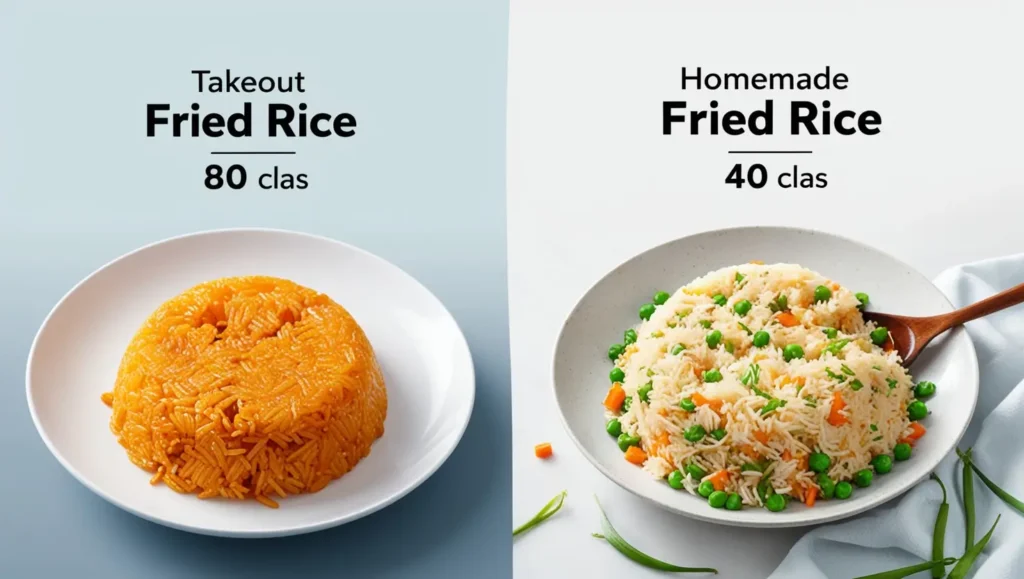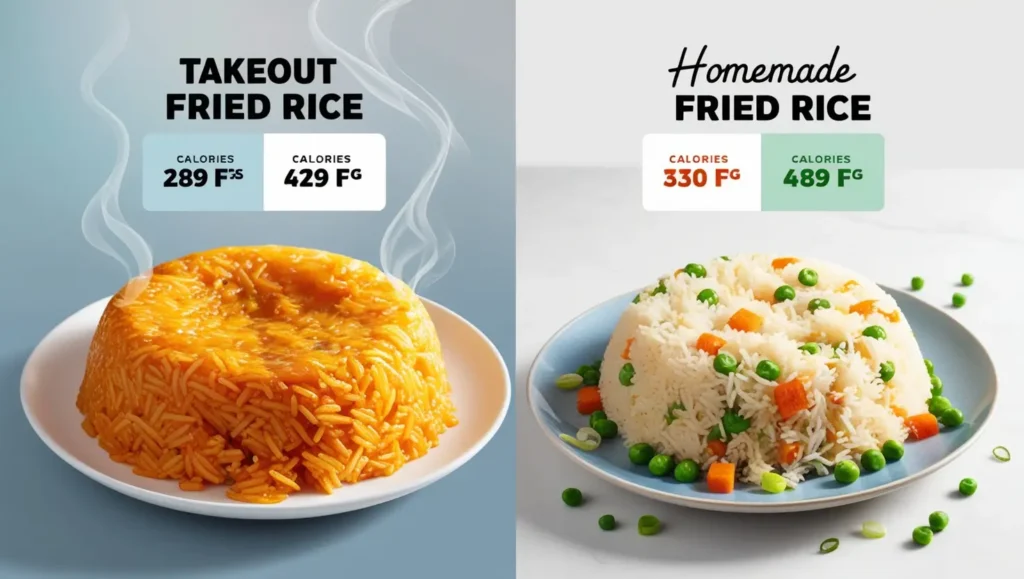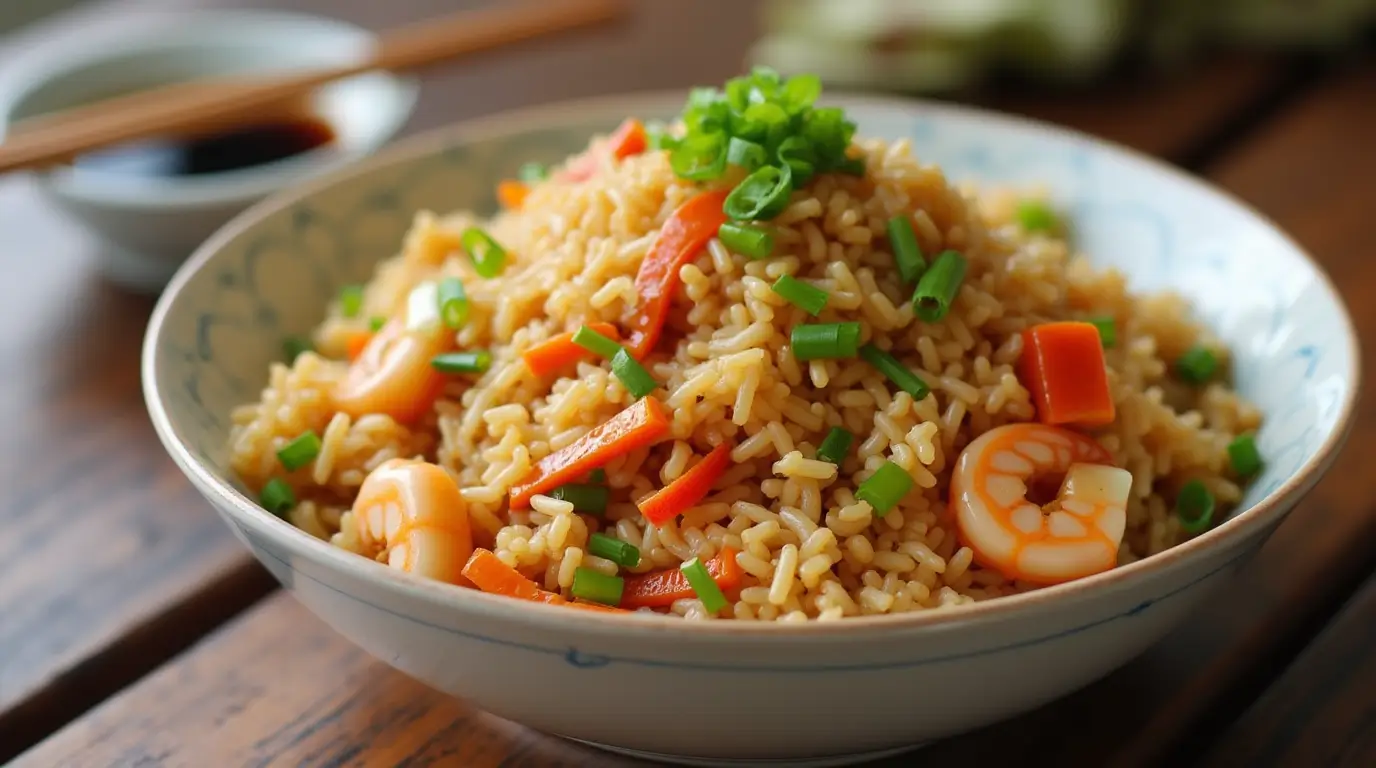Fried rice is a global favorite, but have you ever stopped to think about the calories hiding in this tasty dish? Whether it’s a classic takeout order or a healthier homemade version, fried rice comes in a variety of styles, each with a different nutritional profile. In this article, we’ll explore everything about fried rice calories—from the calorie counts of different types to their nutritional makeup and how to make lighter, healthier versions. Whether you’re looking to manage your weight, tweak your diet, or just satisfy your curiosity, this guide has you covered. Let’s get started!
Understanding Fried Rice and Its Popularity
What is Fried Rice?
Fried rice is a versatile dish made by stir-frying cooked rice with a mix of ingredients like vegetables, proteins, and sauces. Originating in China over a thousand years ago, it’s become a staple across Asian cuisines and beyond. From the fragrant spices of Indian fried rice to the soy-rich flavors of Japanese Yakimeshi, every culture seems to have its own twist on this dish.
What makes fried rice so iconic? For one, it’s a brilliant way to repurpose leftover rice. Plus, the endless ingredient combinations make it adaptable to any palate. Whether you’re craving something spicy, tangy, or savory, fried rice has a version for you.
Why is Fried Rice So Popular?
Well, for starters, fried rice is ridiculously easy to make. Toss some rice into a pan with a few pantry staples, and voila—a hearty meal is ready in minutes! Its popularity also stems from how customizable it is. Love meat? Add chicken or beef. Prefer veggies? Go heavy on the greens. Trying to cut carbs? Substitute cauliflower rice for a low-calorie twist.
Takeout versions, while often indulgent, have earned a permanent spot in fast-food culture. But more and more people are turning to homemade recipes to control calorie content and tailor the dish to their dietary needs. Fried rice isn’t just food—it’s comfort, convenience, and culinary creativity rolled into one.

Nutritional Breakdown of Fried Rice
Caloric Content of Fried Rice Varieties
Not all fried rice is created equal when it comes to calories. The ingredients and preparation methods make a big difference. On average, one cup of fried rice contains between 200 and 400 calories. However, this number can climb higher depending on what’s added.
- Beef Fried Rice: Rich in protein but often higher in fat, a cup of beef fried rice can pack around 350-400 calories. The oils and sauces typically used in takeout recipes add to the calorie count.
- Vegetable Fried Rice: A healthier choice, vegetable fried rice averages about 200-250 calories per cup. Without meat or heavy sauces, it’s lighter but still satisfying.
- Shrimp Fried Rice: Seafood lovers rejoice! Shrimp fried rice usually has fewer calories than beef or pork versions—around 250-300 per cup—while offering plenty of protein.
The caloric variations highlight why it’s essential to check the ingredients when estimating fried rice calories in your favorite dish.
Key Nutritional Components
Fried rice is often packed with macronutrients, but the balance depends on the recipe:
- Carbohydrates: Rice is naturally carb-heavy, making it the primary energy source in this dish. Depending on the type of rice (white or brown), the calorie count can vary. White rice adds quick energy but fewer nutrients, while brown rice offers more fiber and minerals.
- Proteins: Adding proteins like chicken, shrimp, or eggs boosts the nutritional value and makes fried rice more filling.
- Fats: The oils and butter used in stir-frying contribute to the fat content. Soy sauce, another common ingredient, also adds sodium, which can be a concern for some diets.
It’s worth noting that the sauces and seasonings often contain hidden sugars and sodium, which can spike calorie content without you realizing it. For those watching their diet, tweaking these elements can significantly improve the nutritional profile of fried rice.
Healthy Variations of Fried Rice
Substituting Ingredients for Lower Calories
If you’re aiming to lower fried rice calories without sacrificing flavor, ingredient swaps are the way to go. One of the easiest changes is to replace white rice with brown rice or cauliflower rice. Both options provide fewer carbs and, in the case of cauliflower rice, significantly fewer calories—about 25 per cup compared to 200 in white rice.
Next, focus on the add-ins:
- Vegetables: Load up on nutrient-rich veggies like bell peppers, broccoli, and spinach. They not only cut calories but also increase fiber and vitamins.
- Proteins: Swap high-fat meats like pork for lean options such as chicken breast, shrimp, or tofu. These choices reduce calorie density while keeping the dish protein-packed.
Finally, use low-sodium soy sauce or coconut aminos for seasoning. They’re lighter on sodium but deliver a similar umami punch.
Cooking Techniques to Reduce Calories
How you cook fried rice can make all the difference in calorie control. Start by using less oil. Instead of several tablespoons of vegetable oil, try using a light spray of cooking oil or a teaspoon of sesame oil for flavor. A non-stick pan can also help you cut back on excess fats.
Another trick? Steam or microwave vegetables before tossing them in the pan. This reduces the need for extra oil during stir-frying. Additionally, using fresh herbs like cilantro or green onions as garnishes enhances flavor without adding calories.
By tweaking ingredients and techniques, you can enjoy a satisfying dish while keeping fried rice calories in check. Whether you’re cooking at home or modifying a takeout order, these adjustments make it easier to indulge guilt-free!
Comparing Homemade and Takeout Fried Rice
Calories in Homemade Fried Rice vs. Takeout
When it comes to fried rice calories, homemade and takeout versions can differ significantly. Homemade fried rice often averages around 200–300 calories per cup, depending on your choice of ingredients. This is because you have full control over how much oil, rice, and protein goes into your dish.
Takeout fried rice, on the other hand, tends to be calorie-dense, with some portions exceeding 400 calories per cup. Why? Restaurants often use extra oil and butter for that irresistible flavor and texture. Soy sauce and other seasonings can also increase the sodium content, making it less healthy than you might think.
Cooking fried rice at home allows you to skip the unnecessary oils and choose leaner proteins or healthier rice alternatives. For instance, replacing white rice with brown rice or cauliflower rice can significantly cut down on calories.
Tips for Making Healthier Takeout Choices
If you’re craving takeout fried rice but don’t want to blow your calorie budget, don’t worry! Small changes can make a big difference:
- Request less oil or butter: Many restaurants can accommodate lighter preparation methods.
- Skip the extras: Leave out calorie-dense additions like fried chicken, extra sauces, or sugary toppings.
- Control your portions: Split a takeout order into two meals to avoid overeating.

For more inspiration on crafting healthier recipes, check out Kamala Recipes’ Secret Ingredient Restaurant-Style Fried Rice article.
Special Diets and Fried Rice
Fried Rice for Weight Loss
Believe it or not, fried rice can be part of a weight-loss diet. The key lies in managing fried rice calories through smart ingredient choices. Opt for low-calorie options like cauliflower rice, which has around 25 calories per cup compared to 200 in white rice. Additionally, load up on vegetables such as zucchini, carrots, and peas to make your dish more filling without adding many calories.
Protein is another weight-loss-friendly ingredient to consider. Lean meats like chicken breast or plant-based options like tofu can help keep you full for longer. With these tweaks, you can enjoy fried rice without straying from your health goals.
Adapting Fried Rice for Dietary Restrictions
Fried rice is incredibly versatile, making it easy to tailor for various dietary needs. Here are some quick tips:
- Gluten-Free: Use gluten-free soy sauce or tamari to avoid wheat-based sauces.
- Low-Sodium: Reduce the salt content by replacing soy sauce with coconut aminos or making a homemade low-sodium sauce.
- Vegetarian and Vegan: Skip the eggs and opt for tofu, tempeh, or just a medley of colorful veggies.
These adaptations allow everyone to enjoy the flavors of fried rice while sticking to their dietary preferences.
For more delicious and customizable recipes, visit Kamala Recipes and explore their Blackstone Chicken Fried Rice Recipe.
Frequently Asked Questions About Fried Rice Calories
How many calories are in a full plate of fried rice?
The calorie content in a full plate of fried rice depends on the portion size and ingredients. On average, a typical plate (around 2–3 cups) of fried rice can range between 500 and 1,200 calories. Variations with extra oil, butter, or fatty proteins like pork will be on the higher end, while vegetable-based versions with minimal oil are closer to the lower range.
Is fried rice healthy on a diet?
Yes, fried rice can be healthy on a diet if prepared thoughtfully. Opt for healthier ingredients such as brown rice or cauliflower rice instead of white rice. Use lean proteins like shrimp, chicken breast, or tofu, and load up on fiber-rich vegetables. Additionally, reduce the oil and salt to lower calories and sodium. By controlling portion sizes, fried rice can fit well into most diets.
How many calories in a bowl of fried rice?
A standard bowl of fried rice (about 1 cup) usually contains between 200 and 400 calories, depending on the recipe. Vegetable fried rice is typically on the lower end of the calorie range, while variations with meat, sauces, and extra oil tend to be higher.
How many calories are in 2 cups of cooked fried rice?
Two cups of cooked fried rice usually contain 400 to 800 calories, depending on how it’s prepared and the ingredients used. To lower the calorie count while keeping the dish flavorful, you can make simple swaps like using less oil or replacing white rice with healthier options like brown rice or cauliflower rice. These changes not only cut calories but also add more nutrients to the dish.
The Role of Portion Size and Meal Planning
Controlling Portion Sizes for Better Calorie Management
Portion control plays a huge role in managing fried rice calories. Even healthy versions can derail your diet if you overeat. A standard serving size for fried rice is about one cup. To keep portions in check:
- Use a smaller plate or bowl to make your serving look more substantial.
- Pair fried rice with a low-calorie side, like steamed veggies, to feel full without overloading on calories.
- Measure your servings when plating to avoid accidentally eating more than you intended.
Incorporating Fried Rice in Meal Prep Plans
Fried rice is an excellent addition to meal prep plans because it stores well and tastes just as good when reheated. To make a balanced meal:
- Prepare a big batch of vegetable or protein-rich fried rice on the weekend.
- Divide it into individual portions for easy grab-and-go meals.
- Pair each portion with a serving of lean protein, such as grilled chicken or baked tofu, and a side of greens for a complete, nutritious plate.
By planning your meals ahead, you can enjoy fried rice without guilt while ensuring you stick to your health goals. With a little portion control and meal prep, it’s easier than ever to enjoy the flavors you love without worrying about the fried rice calories.
Balancing Taste and Nutrition in Fried Rice
Making Fried Rice Flavorful Without Adding Excess Calories
Balancing flavor and nutrition can seem tricky, but it’s entirely possible with a few smart choices. Traditional fried rice gets its rich taste from oils, soy sauce, and sometimes butter, but these add unnecessary calories. To enjoy the dish guilt-free, try the following:
- Use low-sodium soy sauce: It provides the same umami flavor without the extra salt.
- Add natural flavor boosters: Fresh garlic, ginger, and green onions enhance taste without piling on fried rice calories.
- Incorporate herbs and spices: A dash of chili flakes, sesame seeds, or cilantro adds layers of flavor while keeping the dish light.
These small tweaks allow you to enjoy flavorful fried rice while maintaining a healthier calorie count.
Healthy Ingredient Pairings for Nutritional Balance
To balance fried rice calories, combine it with nutrient-dense ingredients that keep you fuller for longer:
- Lean Proteins: Chicken breast, shrimp, tofu, or eggs boost satiety without adding too much fat.
- High-Fiber Vegetables: Add broccoli, spinach, peas, and carrots to increase fiber, vitamins, and minerals.
- Whole Grains: Opt for brown rice or quinoa instead of white rice for added nutrition and a lower glycemic index.
When you strike the right balance between taste and nutrition, fried rice transforms into a wholesome, satisfying meal that’s perfect for any time of day.

Conclusion: Enjoying Fried Rice Without Guilt
Final Thoughts on Fried Rice Calories
Fried rice is a beloved dish worldwide, but its calorie content often makes people think twice. Luckily, simple ingredient swaps and smarter cooking techniques let you enjoy its rich flavors without derailing your health goals. By using lean proteins, fiber-packed vegetables, and whole-grain options like brown rice, you can lower fried rice calories while boosting its nutritional value.
While takeout fried rice may be tempting, it often hides extra oils, butter, and high-sodium sauces, which can significantly raise the calorie count. Homemade fried rice, however, gives you complete control over the ingredients, making it the healthier and tastier choice. Whether you’re watching your weight, following a specific diet, or just aiming to eat better, fried rice can fit seamlessly into your routine with the right adjustments.
A Final Tip for Healthier Meals
When preparing fried rice, always aim for balance. Use healthy cooking methods, load up on veggies, and keep an eye on portion sizes. This way, you can enjoy the comforting flavors of fried rice without guilt or hesitation.
In the end, fried rice isn’t just about calories—it’s about creativity, customization, and making a dish that suits your unique taste and nutritional needs. So grab your wok, experiment with ingredients, and savor your homemade, guilt-free fried rice!

